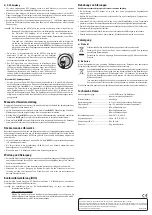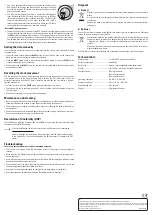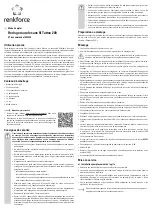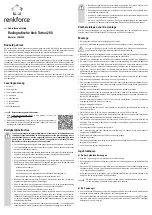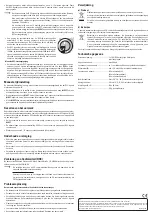
• The clock automatically attempts to synchronise itself with the
DCF signal 12 times a day and waits until the time signal has been
successfully received. This is sufficient to keep the time accurate to
within one second per day.
• The DCF radio time signal, sent from a transmitter in Mainflingen
(near Frankfurt am Main, Germany), has a range of up to 1500 km,
increasing to 2000 km in ideal reception conditions. The DCF signal
contains information such as the exact time and date (with a
theoretical time deviation of one second every million years!). There
is no need to set the summer and winter time manually.
Manual DCF signal reception
• To manually set the clock to search for the DCF signal (for example, when you move the clock
to a new location and need to have the clock search again for the DCF signal), press and hold
the
REC
button for approximately 3 seconds. The hands will move to the home position (12
o’clock) and the clock will attempt to receive a new DCF signal. Wait for the current time to
be displayed (may take up to 12 minutes). If the clock has not received a time signal by then,
the hands will return to the position they were at prior to the attempt.
Setting the time manually
You may want to set the time manually, for example when the clock is not within the DCF signal
reception range.
• To set the time manually, press the
M.SET
button for 3 seconds. As soon as the minute hand
starts to move, you can set the time manually as follows.
• Press the
M.SET
button briefly to adjust the time minute by minute, or keep the
M.SET
button
pressed to adjust the time continuously.
• When you release the
M.SET
button, the set time will be applied after 8 seconds and the clock
will exit manual mode.
Resetting the clock movement
Use this function if the clock no longer responds when you press the buttons or if you encounter
other problems, such as the clock not being able to receive the DCF radio signal. This action
deletes all previously received DCF data. If possible, see whether you can receive a signal at
another location first.
• To reset the clock, press the
RESET
button with a pointed object (e.g. a pen).
• The hands will move to the home position (12 o’clock) and the clock will attempt to receive a
new DCF signal.
• Wait 3 to 12 minutes for the current time to be displayed.
Maintenance and cleaning
• Never use aggressive and abrasive detergents, rubbing alcohol or other chemical solutions, as
these could damage the housing or even impair the functioning of the product.
• The product does not require any maintenance apart from changing the battery; therefore, do
not dismantle it.
• Remove the battery before cleaning. Always clean the product using a clean and dry soft cloth.
Dust can be easily removed using a soft clean brush.
Declaration of Conformity (DOC)
Conrad Electronic SE, Klaus-Conrad-Straße 1, D-92240 Hirschau hereby declares that this product
conforms to the 2014/53/EU directive.
Click on the following link to read the full text of the EU declaration of conformity:
www.conrad.com/downloads
Select a language by clicking on a flag symbol and enter the product order number
in the search box. You can then download the EU declaration of conformity in PDF
format.
Troubleshooting
The clock is not synchronising or only has intermittent reception:
• The clock is out of range of the DCF transmitter or there is interference from geographical
features.
• Move the clock to a different location; switch off interfering devices such as TVs, computers or
microwave ovens.
• Avoid a location close to large metal surfaces, which may block the radio signals. Metal-coated
windows can also affect signal reception.
• To synchronise the clock, place the clock movement by a window with either the front or the
back facing towards Frankfurt am Main (Germany).
• Leave the clock movement switched on overnight to avoid atmospheric interference.
• Reset the movement, as described in section “Resetting the clock movement”.
Disposal
a) Product
Electronic devices are recyclable waste and must not be disposed of in the household
waste.
At the end of its service life, dispose of the product according to the relevant statutory
regulations.
Remove any battery that may have been inserted and dispose of it separately from
the product.
b) Batteries
You as the end user are required by law (Battery Ordinance) to return all used batteries. Disposing
of them in the household waste is prohibited.
Contaminated batteries are labelled with this symbol to indicate that disposal in the
domestic waste is forbidden. The designations for the heavy metals involved are: Cd
= Cadmium, Hg = Mercury, Pb = Lead (name on batteries, e.g. below the trash icon on
the left).
Used batteries can be returned to collection points in your municipality, our stores or
wherever batteries are sold.
You thus fulfil your statutory obligations and contribute to the protection of the environment.
Technical data
Power supply ................................................... 1 x 1.5 V/DC AA battery (not included)
Current consumption ...................................... max. 280 μA
Battery life ........................................................ Approx. 1 year (depending on the battery type)
Dial (Ø) .............................................................. min. 150 mm - max. 350 mm (variable diameter)
Length of hands ............................................... 120 mm (hour hand)
162 mm (minute hand)
140 mm (second hand)
Operating conditions ...................................... 0 to +50 °C, 0 – 90 % RH
Storage conditions.......................................... -20 to +70 °C, 0 – 90 % RH
Dimensions (Ø x D).......................................... 126 x 36.3 mm
Weight ............................................................... 110 g (without battery)
This is a publication by Conrad Electronic SE, Klaus-Conrad-Str. 1, D-92240 Hirschau (www.conrad.com).
All rights including translation reserved. Reproduction by any method, e.g. photocopy, microfilming, or the capture in electronic data
processing systems require the prior written approval by the editor. Reprinting, also in part, is prohibited. This publication represent the
technical status at the time of printing.
© Copyright 2016 by Conrad Electronic SE.
V3_0616_02-DS


